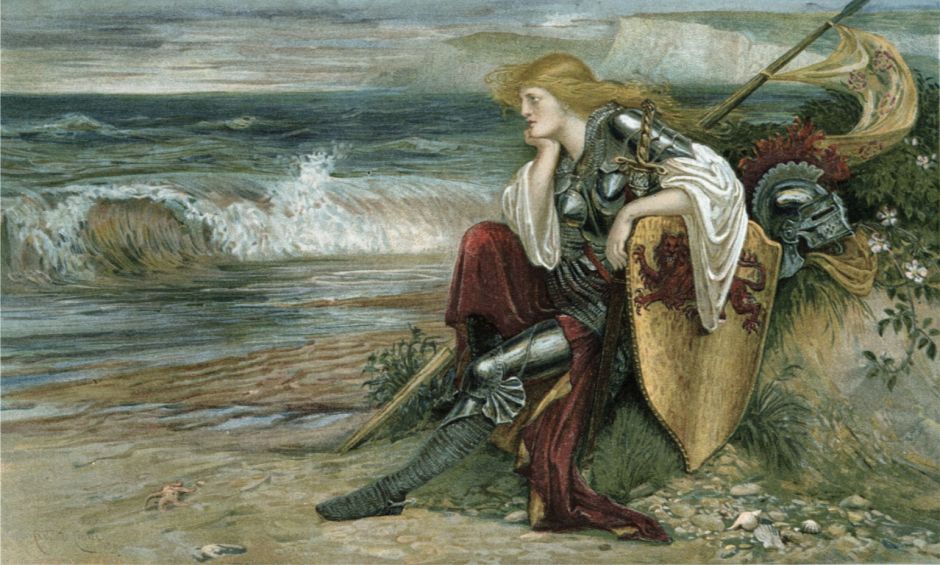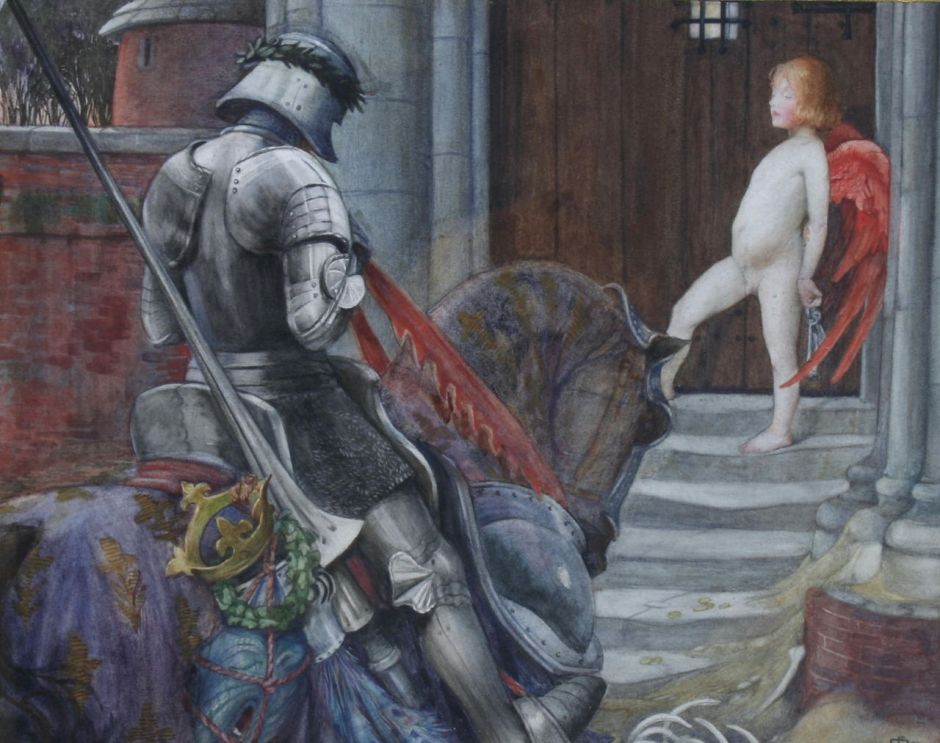In the first of these two articles, I showed a selection of paintings of European knights made from 1500 to 1870. With the dawn of the new art of photography, it’s not surprising that it too started telling stories from Arthurian legends.

The eminent photographer Julia Margaret Cameron must be one of the pioneers in her print of The Parting of Sir Lancelot and Queen Guinevere from 1874. Working mainly in her studio in Freshwater on the Isle of Wight, she posed friends and acquaintances to ‘re-enact’ such scenes in front of her camera.

Emil Teschendorff painted the same scene in his undated Queen Guinevere Bidding Farewell to Sir Lancelot.

For his Knight at the Crossroads (1882), Viktor Mikhailovich Vasnetsov turns to the folk tale of the Three Journeys of Ilya Muromets, the weary knight shown here contemplating which way to go. The stone in front of him apparently advises “If you go straight ahead, there will be no life; there is no way forward for he who travels past, walks past or flies past”. A human skull and part of the skeleton of a horse aren’t encouraging, as crows or ravens wait for his carrion.
Miguel de Cervantes’ Don Quixote is a burlesque comedy about a gentleman who becomes obsessed with contemporary chivalric novels and imagines that he is a knight errant. It was published in 1605 and 1615, and was quickly available throughout Europe in multiple translations. I show here one example of the many paintings of scenes showing the book’s hero as a knight.

Manuel García Hispaleto’s Don Quixote’s Speech of Arms and Letters (1884) shows the hero, his squire Sancho Panza behind, delivering one of his many orations after dinner.

The German painter Hans Thoma is better-known for his landscapes, but in 1889 he painted Lonely Ride showing a mediaeval knight riding alone in full armour, through rolling, hilly countryside. This is strongly reminiscent of the Pre-Raphaelite movement, whose paintings he probably saw when he visited Britain.

Georges Rochegrosse’s Knight of the Flowers from 1894 is far more than frivolous chivalry with a bevy of Playboy bunnies, and was shown at the Salon in Paris in 1894 to critical acclaim. Its theme is, surprisingly, chastity and resistance to temptation, as it’s based on the popular opera Parsifal, which had been so successful at Bayreuth over the previous twelve years.
Wagner’s last opera (1882) was loosely based on a thirteenth-century German epic poem about the Arthurian legend of Parzival (Percival) and his quest for the Holy Grail. The moment chosen by Rochegrosse is the opening of Act 2, Scene 2. Parsifal, the knight and hero, is at Klingsor’s magic castle, where Klingsor summons his enchanted knights to fight Parsifal.
When Parsifal has overcome Klingsor’s knights and put them to flight, he strays into the Flowermaiden garden. Klingsor calls on the seductive sorceress Kundry to seek young Parsifal out and seduce him. Parsifal then finds himself in a beautiful garden, full of flowers, and surrounded by the beautiful and seductive Flowermaidens. They call him and entwine their bodies around him in their efforts to seduce him, but he resists their temptations and remains chaste.
Rochegrosse shows this event in an unusual mixture of styles, with which he felt he expressed the central idea of the scene, that of Parsifal resisting temptation by being “obsessed with the ideal”. There are elements of symbolism in pictorial elements, but the whole painting is realist, with some Impressionist effects in the garden and landscape.

Walter Crane’s watercolour of Britomart from 1900 shows another scene from the first book of Spenser’s Faerie Queene, in which one of several notable women knights has just been left to ride on alone. As is typical in these tales, she may be beautiful but turns out to be a ruthless fighter. Shortly after this pensive moment, she’s threatened with death by another knight, so she impales him with her lance and leaves him for dead.

In Eleanor Fortescue-Brickdale’s watercolour of A Knight and Cupid Before a Castle Door (1900), Cupid, the god of love, is the custodian of the keys to this castle. The knight, who wears a laurel wreath around his helmet indicating victory, must convince Cupid that he is fit to enter. Slung at the side of the knight’s charger are a crown, another laurel wreath, and a sleeping (or dead) dragon.
Around the time of the First World War, knights and their armour appeared in several of Lovis Corinth’s paintings.

Before he suffered his stroke, and the outbreak of the war, Corinth posed as the standard-bearer to a mediaeval knight, his head held high with pride for Prussia.

Soon after the start of the war, Corinth’s patriotism was openly expressed in paintings like Im Schutze der Waffen (In Defence of Weapons) from 1915. The same suit of armour in which he had posed proudly for his self-portrait prior to his stroke now saw service in the cause of his country.

Later in the war, as Germany remained locked in the trenches, Corinth’s suit of armour lost its shine. Götz von Berlichingen (1917) shows the historical character of Gottfried ‘Götz’ von Berlichingen (1480-1562), who had been a colourful Imperial Knight and mercenary. After he lost his right arm in 1504, he had metal prosthetic hands made for him, which were capable of holding objects as fine as a quill. His swashbuckling autobiography was turned into a play by Goethe in 1773, and a notorious quotation from that led to his name becoming a euphemism for the phrase ‘he can lick my arse/ass’.
Following the Armistice of 1918, Corinth painted his empty suit of armour, abandoned on the floor.

During the war, and shortly before his death, John William Waterhouse painted this scene from Tristan and Isolde (1916), in which the couple drink their potion from a golden chalice, while on a ship carrying them back to King Mark. This is based on Wagner’s 1865 opera, in turn based largely on a twelfth century romance by Gottfried von Strassburg.
Chivalric knights are by no means confined to the legends of Western Europe. In East Slavic legend their equivalents are Bogatyrs, who are usually considerably heavier in body but just as errant.

Viktor Mikhailovich Vasnetsov’s Bogatyrs, painted at some time between 1881-98, shows three of these knightly figures.

Mikhail Vrubel’s Bogatyr shows a textbook example in this densely-painted work from 1898. Their role is to defend mediaeval East Slavic and Finnic peoples from invading tribes with their immense strength, bravery and booming voice.
Even the most knightly must eventually come to their end. My final painting, by the British artist Briton Rivière, shows the body of knight laid out in full armour.

Rivière’s Requiescat from 1888 also epitomises the faithful relationship between a dog and its master. This is less about the demise of the knight clad in armour than the devotion of his dog, who sits pining by the side of his body.

